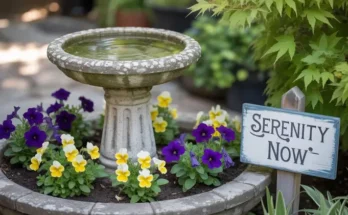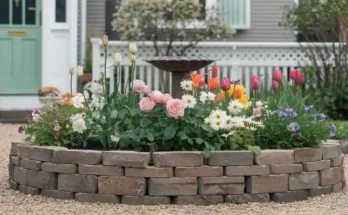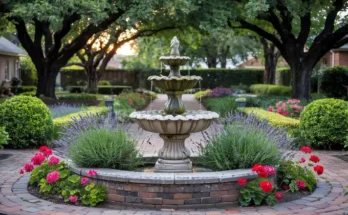Introduction
Japanese gardens exist beyond the level of landscaping because they embody both philosophical meaning and cultural richness and natural alignment. Over the centuries, designers cultivated these gardens to offer both serenity and meditation experiences along with daily stress relief. The guidelines presented here can help anyone design small Zen gardens and choose Japanese landscaping techniques or select water features for any Japanese-style garden.
The Essence of Japanese Garden Design
What Makes a Japanese Garden Unique?
The essence of a Japanese garden revolves around nature while emphasizing simplicity as well as symbolic elements. The Japanese landscape design system diverges from Western gardening through its exclusive emphasis on minimalist aesthetics combined with natural compositional poise and refined grace. Every component receives meticulous placement because the goal is to generate feelings and narrate stories.
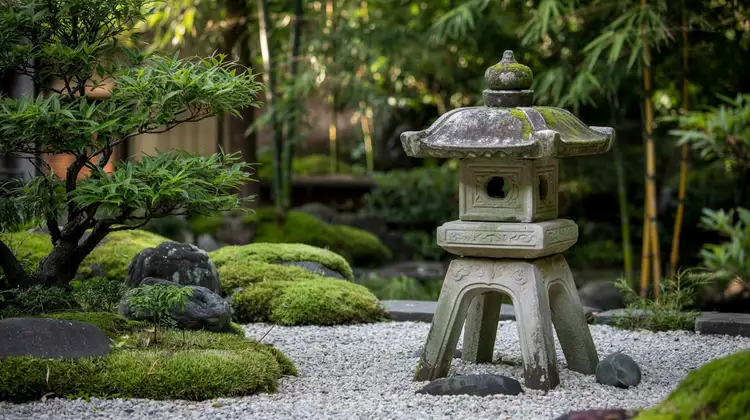
Fundamental Principles of Japanese Garden Landscaping
The distinctive identity of Japanese gardens develops from following specific architectural concepts described below.
Wabi-sabi (Embracing Imperfection)
Japanese gardens uphold the natural state of imperfection, which exists everywhere in the world. The aesthetic value of imperfection should be present in every plant as well as every rock and material in the garden.
Shizen (Naturalness)
Artificial elements should fade into the surrounding natural elements. Overly manicured landscapes are avoided.
Element | Description | Example |
Zen Garden | A minimalist garden focused on meditation and simplicity. | Sand and rocks arranged in patterns. |
Water Features | Essential to create a calm atmosphere through flowing water. | Small ponds, streams, or waterfalls. |
Plants | Carefully selected plants that promote tranquility. | Bamboo, cherry blossoms, and moss. |
Stone Pathways | Winding paths that guide visitors through the garden. | Stones arranged in a natural flow. |
Yūgen (Mystery & Depth)
A garden should provide progressive discovery through hidden secrets that become progressively exposed.
Ma (Space & Balance)
Circular borders of open space carry an equal value to filled areas for the purpose of mental relaxation.
Kanso (Simplicity)
In Japanese gardens, minimalism ensures an effective design. The selected objects have specific functions that guide the design selection.
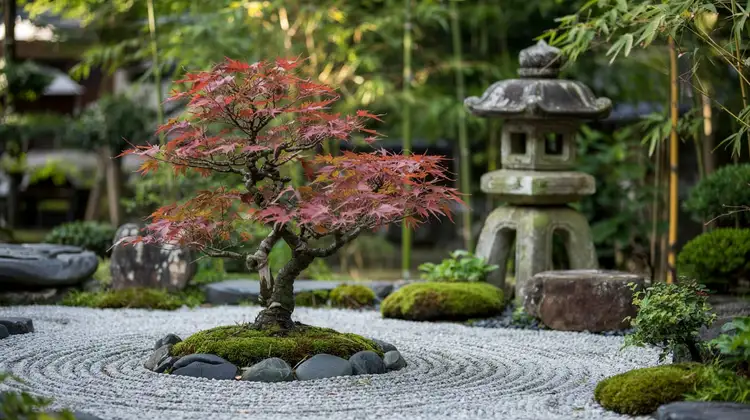
Types of Japanese Gardens and Their Features
Zen Garden (Karesansui)
Zen gardens represent the most popular art form in traditional Japanese landscape design. Dry landscape gardens form aquatic and mountainous shapes out of rocks and sand along with gravel materials.
- Raked gravel symbolizes water movement.
- The garden features strategically arranged rocks that double as mountain and island features.
- The design remains meditative because of its simple plant arrangement.
You can find the traditional Zen garden at temples as well as meditation areas.
Tea Garden (Chaniwa)
Japanese tea gardens exist to serve as spaces where traditional tea ceremonies should be performed. These gardens have:
- The tea house can only be reached through stepping stone paths (Roji).
- Restrictions govern the use of stone water basins (Tsukubai) as hand purification stations for guests.
- The use of bamboo fences permits both solitude and privacy in Japanese landscaping.
- Simple, unpretentious qualities create an environment that promotes relaxation.
Strolling Garden (Kaiyushiki)
A strolling garden should be explored by walking through it to fully experience its views from multiple perspectives.
- Large ponds with bridges and islands.
- Strategic curves in these pathways gradually open up scenes in front of visitors.
- The garden includes seasonal vegetation which provides transforming scenic outlooks throughout different seasons.
Courtyard Garden (Tsuboniwa)
Japanese courtyard gardens become successful space-savers because they fit perfectly into urban gardens with limited space.
- The garden reaches richness from its combination of mosses, ferns and tiny trees.
- Weathered stone lanterns together with bamboo fencing improve the beauty of the space.
- A koi pond or any water element creates visual and auditory impacts in the space.
The Core Components of Japanese Garden Landscaping Include
1. Rocks and Stones (Ishi)
Japanese gardens hinge upon rocks to create their fundamental structure. The garden design uses carefully positioned rocks to represent both mountains and islands as well as natural landscapes.
- Tall upright rocks represent mountains.
- Flat rocks symbolize islands.
- Tobi-ishi stepping stones serve as pathways for people traversing the area.
Element | Description | Example |
Zen Garden | A minimalist garden focused on meditation and simplicity. | Sand and rocks arranged in patterns. |
Water Features | Essential to create a calm atmosphere through flowing water. | Small ponds, streams, or waterfalls. |
Plants | Carefully selected plants that promote tranquility. | Bamboo, cherry blossoms, and moss. |
Stone Pathways | Winding paths that guide visitors through the garden. | Stones arranged in a natural flow. |
Lanterns | Traditional lighting to enhance the ambiance and aesthetic. | Stone lanterns placed near paths or water features. |
Bridges | Small, decorative bridges often placed over ponds or streams. | Wooden or stone bridges crossing small water features. |
Moss | A plant that symbolizes longevity and tranquility in Japanese culture. | Soft moss covering ground areas or rocks. |
Japanese Pines | Evergreen trees that add structure and beauty to the landscape. | Japanese red or white pine trees. |
2. Water Features (Mizu)
Japanese gardens include water as their essential element because it functions as both a life force symbol and a renewal symbol.
- Large gardens frequently contain koi ponds as a feature.
- The flowing water from the falls generates auditory pleasures while producing dynamic motion.
- Shishi-odoshi bamboo water features produce meditation-inducing sounds for animal deterrence and rhythms.
3. Japanese Garden Plants (Shokubutsu)
Selecting appropriate Japanese flora helps keep the garden both fresh in appearance and changing through the seasons.
- During spring, the soft beauty of cherry blossoms known as Sakura blooms to bring aesthetic charm throughout gardens.
- The autumn season brings fiery red foliage to Japanese maples (Acer palmatum).
- Moss arrangements in a garden environment bestow an atmosphere that combines tranquility with historical depth.
- The presence of bamboo trees creates an effect of elevation along with gentle moving lines.
- Pine trees serve as symbols for enduring life while showing capability to withstand hardships.
4. Pathways and Bridges
Japanese garden pathways get planned strategically to achieve fluid movement through space.
- Matte stone paveware (Roji) forms walking paths that direct guests toward tea service facilities.
- The arched wooden bridges classified as Taiko-bashi symbolize journeys across water elements.
- The use of gravel paths guides walkers to pause and meditate during their journey.
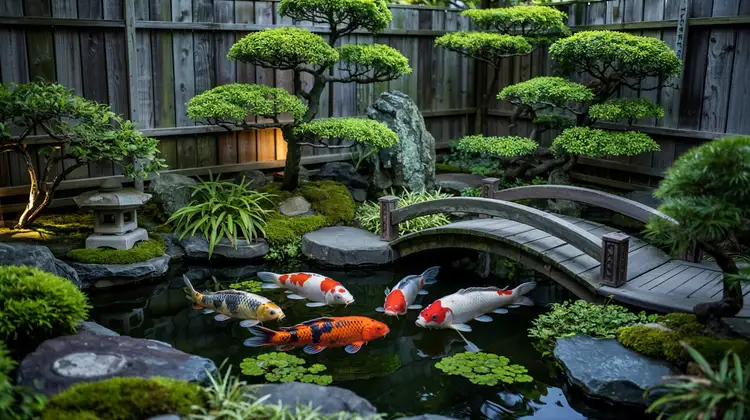
5. Traditional Japanese Garden Ornaments
The traditional decorations enrich the authenticity and cultural elements in the design.
- Stone lanterns (Tōrō) emit gentle lights through their design.
- Bamboo fences offer natural privacy.
- Before entering tea ceremonies, visitors must clean themselves at the water basins designated as Tsukubai.
Guidelines to Design a Traditional Japanese Garden
Step 1: Determine Your Garden’s Purpose
The garden’s main function will decide between Zen meditation and strolling designs along with required features and configuration.
Step 2: Choose a Layout
Draw an uncomplicated garden floor plan that follows balanced design principles.
Step 3: Select Natural Materials
The design remains organic through the selection of stone together with wood and greenery.
Step 4: Install Water Features
A koi pond together with a bamboo fountain along with a basic rock basin stand as important elements for creating a peaceful atmosphere.
Step 5: Add Pathways & Seating
Stepping stones with gravel paths should guide the movement in the garden.
Step 6: Maintain the Garden Regularly
The appearance of tranquility depends on frequent tree pruning and regular stone cleaning while removing all debris and maintaining a neat look through gravel raking.
FAQs
The fundamental components which establish a Japanese garden combine water elements with stones and plants?
The natural concepts of balance and harmony define Japanese gardens which incorporate stones, water, plants and pathways together with decorative ornaments.
Which approach should people use when building a compact Japanese garden design?
A Japanese garden measuring only a small area should incorporate a rock selection with moss additions and stepping stones together with a bamboo fountain. The essential design principle for such spaces remains minimalism as well as balance.
Which steps should I take to maintain my Japanese garden effortlessly?
A successful drought-resistant Japanese garden depends on choosing plants such as moss together with raked gravel and bamboo while simplifying the landscape design.
Raked patterns within Zen gardens possess what meaning to their overall design?
The art of raking patterns symbolizes water waves and ripples to produce a peaceful effect on observers.

Conclusion
A Japanese garden serves as more than a conventional landscape because it provides space where people can establish peace while meditating and deepening their bond with nature. Traditional Japanese principles and design guidelines assist you in constructing tranquil spaces that endure forever, regardless of garden size.
The guide incorporates market-relevant keywords to help your Japanese garden project find potential audience members who are looking for online assistance. Japanese garden design creates a life-sized artwork in nature which provides peace and visual elegance that will last many years.


